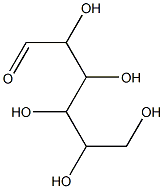Carboxymethyl cellulose

- CAS No.
- 9000-11-7
- Chemical Name:
- Carboxymethyl cellulose
- Synonyms
- CMC;croscarmellose;Carmellose;2,3,4,5,6-pentahydroxyhexanal;kmts;CM CELLULOSE;pentahydroxyhexanal;acetic acid,2,3,4,5,6-pentahydroxyhexanal;7h;E466
- CBNumber:
- CB3399316
- Molecular Formula:
- C6H12O6
- Molecular Weight:
- 180.15588
- MOL File:
- 9000-11-7.mol
- MSDS File:
- SDS
- Modify Date:
- 2024/7/26 15:15:06
| Density | 1.050 g/cm3(Temp: 15-18 °C) |
|---|---|
| FEMA | 2239 | CARBOXYMETHYLCELLULOSE |
| solubility | Practically insoluble in anhydrous ethanol. It swells with water to form a suspension and becomes viscid in 1 M sodium hydroxide. |
| form | preswollen, microgranular |
| color | White to off-white |
| Odor | odorless |
| Stability | Stable. Combustible. Incompatible with strong oxidizing agents. |
| InChI | InChI=1S/C6H12O6/c7-1-3(9)5(11)6(12)4(10)2-8/h1,3-6,8-12H,2H2 |
| InChIKey | GZCGUPFRVQAUEE-UHFFFAOYSA-N |
| SMILES | C(=O)C(O)C(O)C(O)C(O)CO |
| LogP | -3.17 |
| CAS DataBase Reference | 9000-11-7(CAS DataBase Reference) |
| EPA Substance Registry System | Cellulose, carboxymethyl ether (9000-11-7) |
SAFETY
Risk and Safety Statements
| WGK Germany | 1 |
|---|---|
| RTECS | FJ5700000 |
| HS Code | 3912310000 |
| Toxicity | LD50 unreported in mammal (species unspecified): 13340mg/kg |
Carboxymethyl cellulose Chemical Properties,Uses,Production
Chemical Properties
Cellulose is a natural substance normally present in most diets because it is the major structural carbohydrate of green
plants. Cellulose is essentially a linear polymer of glucopyranose units connected by α-1,4-glucoside links. In nature, cellulose is
present in plant cell walls as fibers. The molecular weight of the isolated cellulose is approximately 50,000 daltons. The principal
sources of cellulose for food-related purposes are cotton linters and wood pulp.
Chemical processing converts cellulose into forms or derivatives suitable for incorporation into food products or for use in food
packaging materials. For food use, the optimum degree of substitution of a carboxymethyl-residue on each anhydroglucopyranose
unit on cellulose is 0.95. By preliminary mild acid hydrolysis, the degree of polymerization (i.e., molecular size) of the cellulose
may be reduced before carboxymethylation. Control of the degree of substitution and the degree of polymerization during processing
results in production of a wide variety of derivatives that differ in such physical properties as gelling, temperature, viscosity and
dispersibility in water. Sodium carboxymethyl cellulose is used as a thickening agent and stabilizer in foods. Because carboxymethyl
cellulose is spontaneously converted to sodium salt in alkaline solution, it is probable that any distinction between carboxymethyl
cellulose and sodium carboxymethyl cellulose in foodstuffs is artificial.*
Uses
carboxymethyl cellulose (cellulose gum) is a thickener. used in cosmetic formulations when a reactant is not required or desired. often used in bath preparations, beauty masks, hand creams, and shampoos. It is considered a non-comedogenic raw material.
Preparation
Sodium carboxymethyl cellulose is produced by treating wood pulp or cotton linters with alkali and monochloroacetic acid. It occurs as a white- or cream-colored powder or granules.
Industrial uses
Carboxymethyl cellulose is manufactured with molecular weights ranging from 50,000 to 800,000. Several modifications are of interest to flotation because they display good depressing properties for highly floatable magnesium-bearing minerals. These include sodium salts of phenolphthalein ether cellulose and ethanesulfo cellulose.
Carcinogenicity
Sarcomas were produced at the site of repeated subcutaneous injection of aqueous solutions of carboxymethylcellulose. It should be noted, however, that massive doses were given and therefore there must have been considerable local trauma.
Carboxymethyl cellulose Preparation Products And Raw materials
| Supplier | Tel | Country | ProdList | Advantage | Inquiry |
|---|---|---|---|---|---|
| Sri Chemicals | +91-4426207575 +91-4442127722 | Tamil Nadu, India | 21 | 58 | Inquiry |
| Cellulose Pharma Chem | +91-9823078051 +91-9823078051 | Maharashtra, India | 6 | 58 | Inquiry |
| Ralington Pharma | +91-7948911722 +91-9687771722 | Gujarat, India | 1350 | 58 | Inquiry |
| Ashahi Chemical Industries Ltd | +91-2762252228 +91-9714008789 | New Delhi, India | 15 | 58 | Inquiry |
| NB Laboratories Pvt Ltd | +91-7666900215 +91-9923397866 | Maharashtra, India | 3 | 58 | Inquiry |
| Unisynth Chemicals | +91-9820430673 +91-9820430673 | Maharashtra, India | 32 | 58 | Inquiry |
| Agilenobel | +91-8090295395 +91-8800293647 | Haryana, India | 50 | 58 | Inquiry |
| Lucid Colloids Ltd. | +91-2224158059 +91-2224158059 | Maharashtra, India | 5 | 58 | Inquiry |
| Arihant Innochem Pvt Ltd | +91-2267674895 +91-2267674895 | Mumbai, India | 37 | 58 | Inquiry |
| Ennor Muds and Chemicals | +91-8754442175 +91-9840477722 | Tamil Nadu, India | 26 | 58 | Inquiry |
| Supplier | Advantage |
|---|---|
| Sri Chemicals | 58 |
| Cellulose Pharma Chem | 58 |
| Ralington Pharma | 58 |
| Ashahi Chemical Industries Ltd | 58 |
| NB Laboratories Pvt Ltd | 58 |
| Unisynth Chemicals | 58 |
| Agilenobel | 58 |
| Lucid Colloids Ltd. | 58 |
| Arihant Innochem Pvt Ltd | 58 |
| Ennor Muds and Chemicals | 58 |
Related articles
- Important chemical materials - sodium carboxymethyl cellulose
- Carboxymethyl cellulose (CMC) is obtained after carboxymethylation of cellulose. Its aqueous solution has the functions of thi....
- Apr 8,2022





